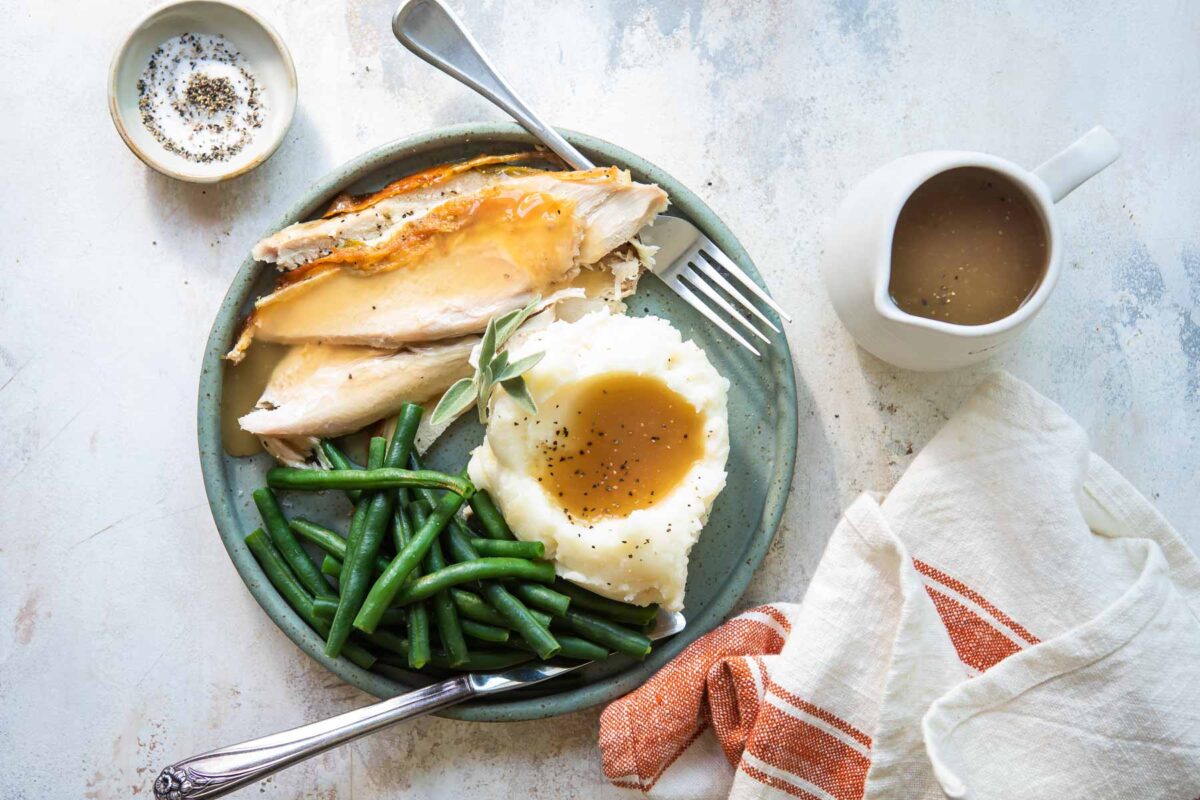Making gravy from chicken juices may seem intimidating but it’s actually quite simple with just a few basic steps. Gravy is a tasty way to bring moisture and flavor to meals like mashed potatoes rice, biscuits, and more. The key is starting with flavorful chicken juices and thickening them properly into a luxurious gravy.
Gather the Chicken Juices
The first step is cooking a chicken and collecting the juices. You can use a whole roasted chicken baked chicken pieces sautéed chicken, or any cooking method that results in flavorful pan juices.
As the chicken cooks, liquid will accumulate in the bottom of the pan. Be sure to scrape up any browned bits stuck to the pan – this is concentrated chicken flavor that will add depth to your gravy! Transfer the chicken to a plate to rest.
Pour the juices from the pan into a measuring cup. You should aim for around 1-2 cups of liquid. Add extra chicken broth if needed to reach the right amount.
Prepare the Thickener
For a smooth, lump-free gravy, you’ll need a thickener. The most common options are
-
Flour: Whisk together 1-2 tablespoons flour with an equal amount of butter or oil until smooth.
-
Cornstarch: Dissolve 1-2 tablespoons cornstarch in a bit of cold water.
-
Roux: Cook equal parts flour and butter until golden brown.
Flour or cornstarch are easiest. Roux adds the deepest flavor but requires cooking the roux first.
Make the Gravy
Now it’s time to turn those chicken juices into gravy! Follow these steps:
-
Pour juices into skillet. Return the pan juices to the skillet you cooked the chicken in. Place over medium heat.
-
Add aromatics. For extra flavor, sauté minced aromatics like garlic, onions, or shallots in the pan juices briefly until fragrant.
-
Whisk in thickener. Pour your thickening mixture – flour slurry, cornstarch slurry, or roux – into the juices while whisking constantly.
-
Simmer until thickened. Keep whisking! Let the gravy simmer until thickened, about 5 minutes. The flour or cornstarch will absorb moisture from the juices and thicken them into gravy.
-
Season generously. Once thickened, season the gravy to taste with salt, pepper, herbs, and spices. Chicken gravy loves sage, thyme, rosemary, and oregano.
-
Strain for smoothness (optional). For lump-free gravy, pour through a mesh strainer before serving.
Gravy Tips and Tricks
-
Spoon extra fat from the top of the juices for a healthier gravy.
-
Add milk, cream, or broth for an ultra silky and luxurious texture.
-
Splash in a bit of white wine or sherry for added sophistication.
-
Mix in pan drippings from roasted turkey, pork, or beef for more flavor complexity.
-
Cook the roux in the pan you browned the chicken for extra fond in the gravy.
-
For a quick thickener, shake in some instant mashed potato flakes while whisking.
-
Keep gravy warm in a double boiler or gravy boat until ready to serve.
-
Make gravy ahead and refrigerate or freeze it for quick meals later. Reheat gently before serving.
-
Substitute cornstarch for flour to make gluten free chicken gravy.
Serving Suggestions for Chicken Gravy
Chicken gravy is extremely versatile. Here are some delicious ways to use it:
-
Biscuits and gravy: Split fresh biscuits and ladle on hot chicken gravy for a comforting Southern classic.
-
Mashed potatoes: Mix chicken gravy into mashed potatoes for next-level flavor and moisture.
-
Chicken fried steak: Smother chicken fried steak or pork chops in creamy chicken gravy.
-
Weeknight rice: Spoon chicken gravy over instant rice or rice pilaf for an easy meal.
-
Pot pie: Use chicken gravy as the base for chicken pot pie or shepherd’s pie.
-
Casseroles: Incorporate chicken gravy into casserole recipes like green bean, broccoli rice or chicken & stuffing.
-
Roast chicken: Pass extra gravy at the table for roast chicken, turkey or glazed ham.
-
Breakfast: Wake up to sausage gravy over buttermilk pancakes or biscuits.
Chicken gravy is endlessly versatile. Keep some on hand in the fridge or freezer and you’ll always have the start of a satisfying home cooked meal.
Common Questions About Chicken Gravy
Here are answers to some frequently asked questions about making chicken gravy:
How do you thicken chicken juices into gravy?
Whisk flour, cornstarch, or a roux into the chicken juices and simmer until thickened to the desired consistency. Flour or cornstarch dissolved in water are the easiest options.
What can you use instead of flour to thicken gravy?
Cornstarch and arrowroot work well as alternate thickeners. For gluten-free gravy, use cornstarch, arrowroot, potato starch, instant mashed potatoes, or xanthan gum.
Why is my gravy lumpy?
Lumps mean the flour or cornstarch wasn’t fully dissolved before adding it to the hot liquid. Next time, make sure to whisk the slurry and juice together very well as it simmers to prevent lumps. Straining after simmering can also remove lumps.
How can you fix a gravy that’s too thin?
If your gravy comes out too thin, simmer it a bit longer to thicken or whisk in more thickener like flour, cornstarch, or instant mash potatoes. Adding cream or milk will thin it further rather than thicken.
Can you freeze and reheat gravy?
Absolutely! Let gravy cool completely then transfer to freezer bags or containers. Thaw in the refrigerator before reheating gently on the stovetop or microwave. Add a splash of milk or broth if it needs thinning after reheating.
Making great gravy from chicken juices is easy with the right techniques. Follow this guide and you’ll be able to whip up flavorful, smooth gravy anytime. Get creative with different seasonings and ingredients and you’ll have a new go-to gravy recipe perfect for any meal.

Recipe tips and variations
- Yield: This recipe makes about 6 cups gravy, enough for twelve (1/2-cup) servings.
- Storage: Store leftovers covered in the refrigerator for up to 4 days.
- Roast chicken: You don’t need a whole bird to make gravy. An assortment of cooked chicken parts, such as chicken thighs, quarters, or breasts, work too. Just aim for bone-in, skin-on chicken for maximum flavor. Boneless, skinless chicken breasts won’t release enough fat to make gravy.
- Fond = flavor: Make sure you get every last bit of the “fond,” the culinary term for the browned bits that cling to the pan after roasting.
- Make the slurry: Don’t skip the slurry. If you add dry cornstarch to hot liquid, it will clump.
- Herbs and spices: Add more flavor to your gravy with garlic powder, onion powder, thyme, sage, or rosemary. Add these with the broth in Step 2.
- White wine: For a splash of acidity in the gravy, add a little bit of white wine.
- Turkey gravy: For turkey gravy, substitute pan drippings from a roasted turkey.
- Let the meat rest: Making gravy is the perfect thing to do while the chicken rests before carving. Keep it warm, and by the time the gravy is done, you’ll be ready to carve.

Part fat and part all-purpose flour, a roux is a culinary technique for thickening sauces, including gravy. My chicken gravy uses a slurry made with cornstarch for a gluten-free gravy.
My recipe is written with cornstarch, but you can certainly substitute flour. To substitute flour for the cornstarch, remove most of the fat from the roasting pan. Add the flour and cook, mixing with the drippings, until the raw flour smell disappears. Add the broth and scrape the bottom of the pan. No need to strain off the extra fat; just pour the gravy into a saucepan and continue with the recipe.
Chicken and Turkey Recipes
Chicken and Turkey Recipes
Chicken and Turkey Recipes
Chicken and Turkey Recipes

